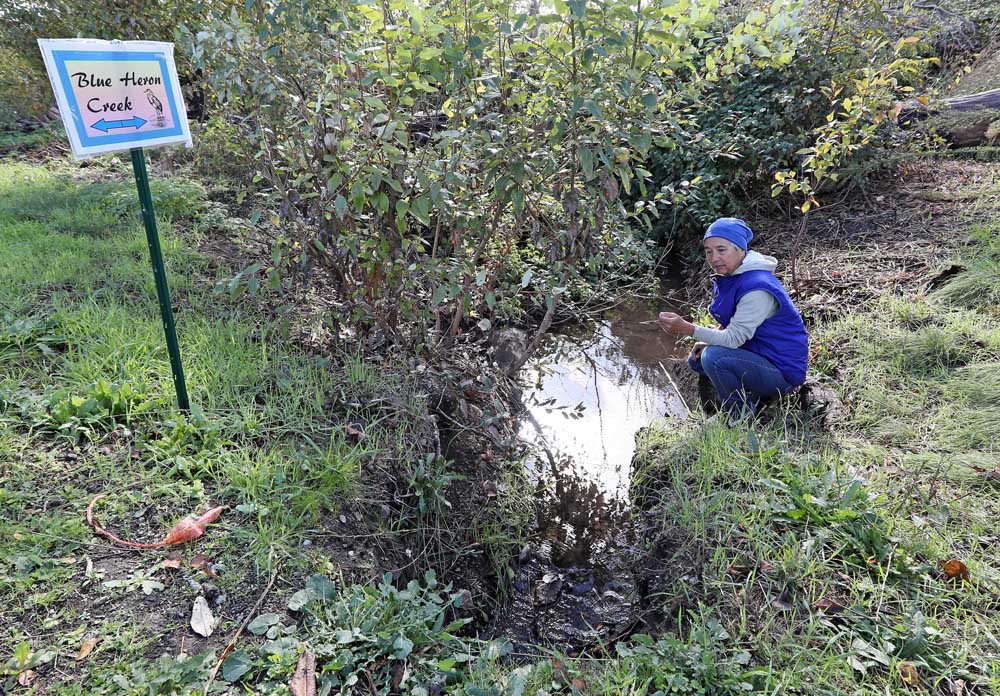Newly named Blue Heron Creek provides clean, cold spring water to Bear Creek
Published 8:15 pm Sunday, November 5, 2023

- Frances Oyung, with Rogue Riverkeeper, says small springs like Blue Heron Creek help to cool down Bear Creek during hot summer months.
Newly named Blue Heron Creek in Phoenix might be small, but it’s valuable, according to those seeking to protect it and other creeks like it.
The creek, which is about 1,000 feet long, is one of several short, spring-fed creeks located in what’s been dubbed a “miracle mile” of springs and seeps feeding cold water to Bear Creek. Cold water benefits fish.
The U.S. Board on Geographic Names on Oct. 12 approved the name Blue Heron Creek, named after nearby Blue Heron Park. Proponents hope the name will bring awareness to the need for protection.
Frances Oyung of Rogue Riverkeeper visited the site last week, showing where springs on both sides of the park entrance flow to feed a meandering waterway a few feet wide. The creek flows through city, state and private property to a wetland beside Bear Creek, downstream from the park.
“It’s little, for sure,” Oyung said. “We’re talking about clean, cold spring water.”
Fish need cold water to stay healthy. The creek flows year-round, providing habitat for wildlife.
“If you come in here in August, there’s a trickle,” Oyung said.
At the head of the creek, water gurgled up from a spring box — a place for water to collect — and flowed downstream past the foundation of an old milk house, where milk could be kept cold “back when milk was stored in metal cans with lids,” Oyung said.
A dairy used to be located nearby.
Some of the creek banks are steep and covered in brush, in an area the city would prefer people avoid for safety reasons and for the protection of resources. A good place to view the creek is where the Bear Creek Greenway crosses it a few hundred feet north of the park’s entry road.
From the greenway, the creek flows toward Bear Creek, although an old highway berm blocks its final path to the larger creek. From the wetland there, it’s assumed that the water seeps underground into Bear Creek. Efforts are underway to remove the berm, possibly next year.
The Almeda Fire of 2020 swept through the area, ravaging the creek corridor and surrounding neighborhoods, but it also burned away brush to reveal the springs.
“This was all totally no vegetation,” Oyung said. “There was zero living vegetation here.”
“Before the fire, it was covered in eight feet of blackberries.”
Many burned trees remain standing, with some new growths of cottonwoods springing up, their roots not killed by the flames.
“These cottonwoods have come up on their own,” Oyung said.
Blackberries were coming back, too, although Oyung and others would like to see them kept in check. They crowd out native plants and provide fuel for fire. Some blackberries are native.
The naming of the creek is more than a symbolic act.
“It means [the creek] will get some recognition of its contribution,” Oyung said. “It’s going to get on a few maps. If people want to develop this, it will be recognized as a stream.
“Any waterway that has been recognized with a name, they get a little more status and consideration in the regulatory world.”
The effort to name the creek began two years ago, after a small group of citizens concerned about development encroaching on wetlands near the park formed an informal group called Save the Phoenix Wetlands. It was that group and Rogue Riverkeeper that applied for the naming. Rogue Riverkeeper is a program of the Ashland-based environmental organization KS Wild.
During their work, and as a result of the fire, group members became aware of several unnamed creeks — some of them only a few hundred feet long — located on the south side of Bear Creek mainly between Blue Heron Park and the Interstate 5 interchange at North Phoenix Road, less than a mile downstream.
It’s uncertain if the save the wetlands group will attempt to name other unnamed creeks.
“Whether this group is going to work on more, we’re trying to figure that out,” Oyung said. “It takes a lot of effort.”
In their application to name the creek, the two groups received support from a range of individuals and organizations, although the city’s urban renewal agency, which owns one of the springs that creates Blue Heron Creek, declined to take a stand. Support came from a property owner through which the creek flows. Also, the Oregon Department of Transportation supported the naming. The berm and portions of the creek are on state land administered by the agency.
In their application, the groups wrote that the creek had been “overlooked by citizens, the city and local planning processes alike.” When the geographic names board approved the naming, the groups issued a joint announcement. “Small streams, wetlands, and springs in the region are critical for protecting water quality and habitat for native fish,” they said. “Unnamed waterways do not receive the same protection and attention from residents and agencies and this tributary has not had a documented name in recorded history, putting its survival at risk.”
In their application, the groups wrote that the creek had been “overlooked by citizens, the city and local planning processes alike.” When the geographic names board approved the naming, the groups issued a joint announcement.
“Small streams, wetlands, and springs in the region are critical for protecting water quality and habitat for native fish,” they said. “Unnamed waterways do not receive the same protection and attention from residents and agencies and this tributary has not had a documented name in recorded history, putting its survival at risk.
“This spring-fed waterway, now named Blue Heron Creek, will continue to provide habitat and cold water refuge for several species of fish and aquatic organisms as well as invertebrates, birds, and pollinators.”
The naming also was endorsed by the Oregon Department of Fish and Wildlife.
“Naming will create awareness of the creek and will eventually help protect native riparian vegetation that keeps all streams in the Rogue watershed cool and productive,” said Dan Van Dyke, an ODFW fish biologist based in Medford. “Our native salmon and steelhead need cool water to thrive.”
Robert Coffan, a hydrologist and member of the Save the Phoenix Wetlands group, said the creek certainly deserved a name.
“The consistent cold water that this spring-fed creek provides through the hot summer months is a unique gift for the fish in Bear Creek and the entire Rogue Basin,” he said.
Coffan said the fact that the spring-fed creeks in the area are short means that they don’t have much chance to heat up before delivering cold water to Bear Creek, where fish gather near the cooler flows.
“These springs are often a stone’s throw away” from Bear Creek, Coffan said.
Scott English, a wildlife biologist and member of the save the wetlands group, said he expects the fight to go on to protect the spring-fed creeks in Phoenix.
“The big picture is this is just the beginning of highlighting a number of those springs,” English said.
Members of the group are passionate about their cause, he said.
“They really want to see these incredible springs and cold water refugia protected.”
The need for protection, English continued, was made more important because of global warming and associated high-heat events. Bear Creek already gets hot in the summer, well beyond what’s ideal.
“These hot spells are going to get worse and worse and worse,” English said.
Other group members expressed support for continuing the fight.
“Bear Creek, with its associated streams and wetlands, is a life-giving artery supporting fish and wildlife throughout the Rogue Valley,” group member Haila Williams said. “Let’s protect it.”






